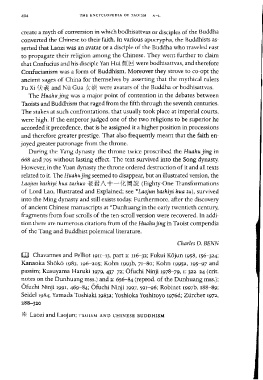Page 534 - The Encyclopedia of Taoism v1_A-L
P. 534
494 THE ENCYCLOPEDIA OF TAOISM A-L
create a myth of conversion in which bodhisattvas or disciples of the Buddha
converted the Chinese to their faith. In various apocrypha, the Buddhists as-
serted that Laozi was an avatar or a disciple of the Buddha who traveled east
to propagate their religion among the Chinese. They went further to claim
that Confucius and his disciple Yan Hui ~i ~ were bodhisattvas, and therefore
Confucianism was a form of Buddhism. Moreover they strove to co-opt the
ancient sages of China for themselves by asserting that the mythical rulers
Fu Xi 1J\: ~ and Nu Gua !;: ~I,',\ were avatars of the Buddha or bodhisattvas.
The Huahu jing was a major point of contention in the debates between
Taoists and Buddhism that raged from the fifth through the seventh centuries.
The stakes at such confrontations, that usually took place at imperial courts,
were high. If the emperor judged one of the two religions to be superior he
accorded it precedence, that is he assigned it a higher position in processions
and therefore greater prestige. That also frequently meant that the faith en-
joyed greater patronage from the throne.
During the Tang dynasty the throne twice proscribed the Huahu jing in
668 and 705 without lasting effect. The text survived into the Song dynasty.
However, in the Yuan dynasty the throne ordered destruction of it and all texts
related to it. The Huahu jing seemed to disappear, but an illustrated version, the
Laojun bashiyi hua tushuo l;{; tt J\.. +~1t fill ~ (Eighty-One Transformations
of Lord Lao, Illustrated and Explained; see *Laojun bashiyi hua tu), survived
into the Ming dynasty and still exists today. Furthermore, after the discovery
of ancient Chinese manuscripts at *Dunhuang in the early twentieth century,
fragments from four scrolls of the ten-scroll version were recovered. In addi-
tion there are numerous citations from of the Huahu jing in Taoist compendia
of the Tang and Buddhist polemical literature.
Charles D. BENN
m Chavannes and Pelliot I9II-I3, part 2: rr6-32; Fukui K6jun 1958, 156-324;
Kanaoka Sh6k6 1983, 196-205; Kohn 1993b, 71-80; Kohn 1995a, 195-97 and
passim; Kusuyama Haruki 1979, 437-72; Ofuchi Ninji 1978-79, I: 322-24 (crit.
notes on the Dunhuang mss.) and 2: 656-84 (reprod. of the Dunhuang mss.);
Ofuchi Ninji 1991, 469-84; Ofuchi Ninji 1997, 591-96; Robinet I997b, 188-89;
Seidel 1984; Yamada Toshiaki 1983a; Yoshioka Yoshitoyo 1976d; Zurcher 1972,
288-320
* Laozi and Laojun; TAOISM AND CHINESE BUDDHISM

